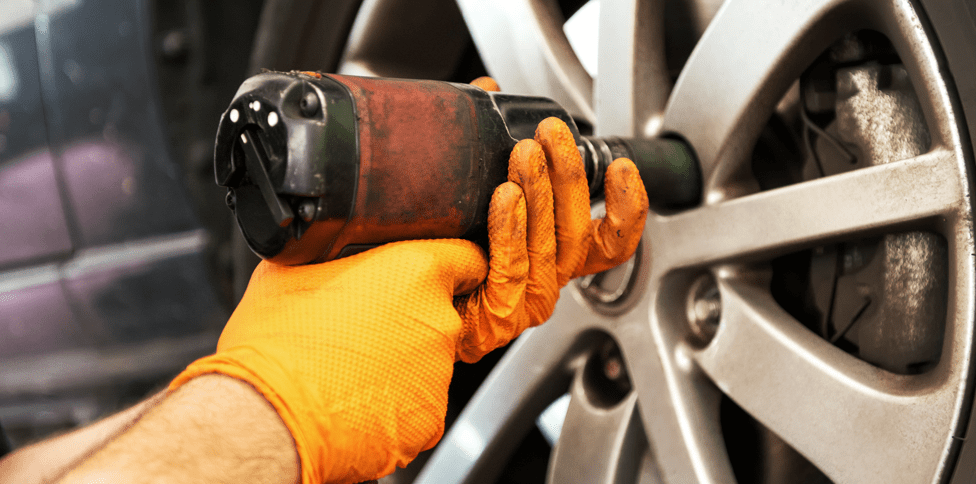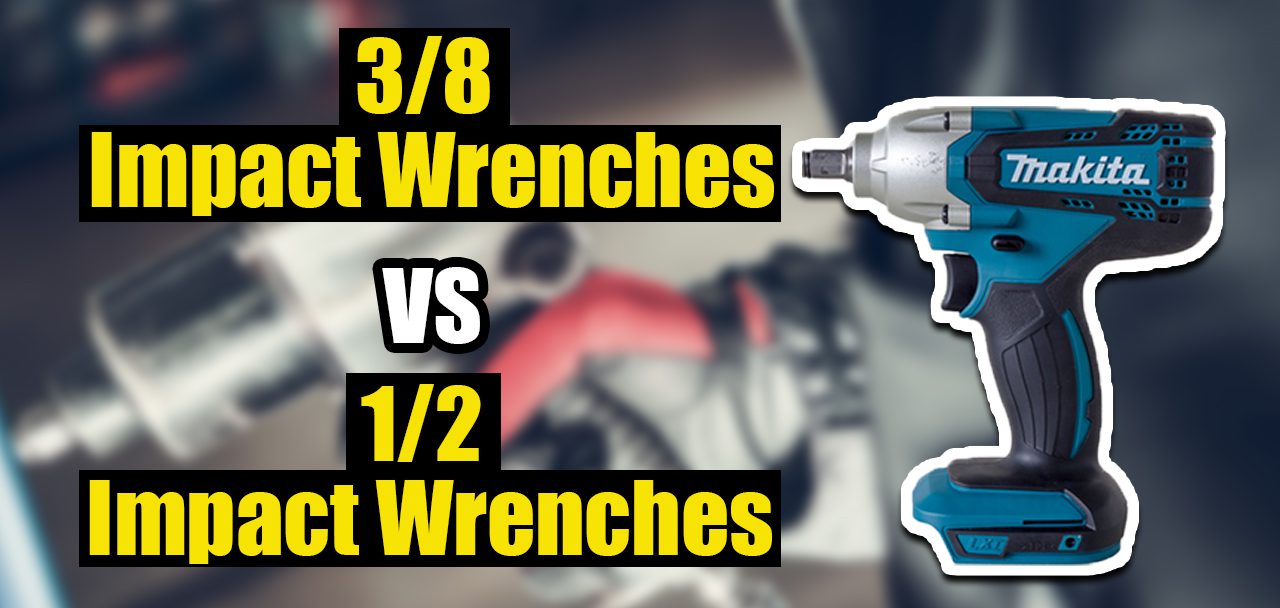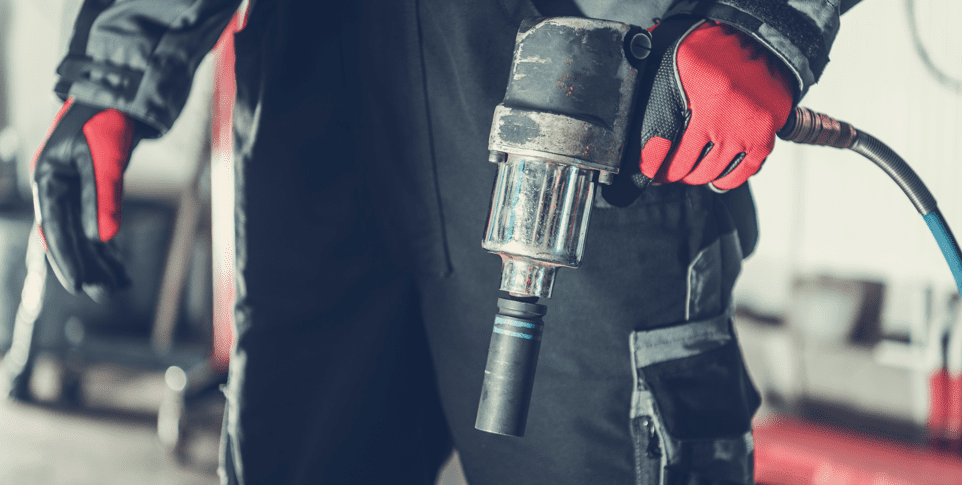Do you want to buy an impact wrench but aren’t sure where to begin? Having trouble telling a 3/8-inch impact wrench apart from a 1/2-inch impact wrench?
There’s a lot of conflicting information out there on the internet, which is why I chose to write this article about the differences between a 1/2-inch and a 3/8-inch impact wrench.
This will, hopefully, allow you to make the best decision, whether to get a 1/2 impact wrench or a 3/8 impact wrench.
Let’s begin.
3/8 vs 1/2 Impact Wrench: In-Depth Comparison
There are five critical distinctions between a 3/8-inch and a 1/2-inch impact wrench that you should be aware of before making your purchase.
Let’s go one by one.
Power
A good friend told me that the more power output a tool gives, the better it is.
In that case, a 1/2 impact wrench wins the battle against a 3/8 impact wrench as it has a much more powerful motor that delivers a higher maximum torque level to remove rusted nuts and bolts.
Indeed, 3/8-inch impact wrenches generally deliver 90 to 100 ft/lbs of maximum torque, whereas 1/2-inch impact wrenches often offer at least 300 ft/lbs of maximum torque.
That’s a big difference right there.
So, 1/2-inch impact wrenches are considerably better suited (i.e., working on stubborn bolts).
For jobs requiring less than 150 ft/lbs of maximum torque, 3/8 Impact wrenches are preferable.
Size & Weight
Well, there are two differences between these kinds of impact wrenches regarding their size.
To begin with, there’s the matter of total weight.
A 1/2 impact wrench has a more powerful motor and a bigger battery to give power to it, which adds to the overall weight compared to its 3/8 counterpart.
In fact, it’s pretty common to find 1/2 impact drivers weighing around 7 pounds while 3/8 impact wrenches weigh approximately 2 lbs (less than half).
The second difference resides in the dimensions of the tools.
The larger and more powerful components of 1/2 impact wrenches make them bulkier, allowing them to generate considerably more torque.
On the other hand, ⅜ impact wrenches are substantially smaller, which gives them the advantage of fitting better in tight spaces.
Functionality
As previously mentioned, a 1/2 impact wrench is larger and bulkier than a 3/8 impact wrench due to its larger and bulkier components (bigger battery, more powerful motor, etc.).
Therefore, I would say that due to its form factor, a 3/8 impact wrench is much more portable than its 1/2 counterpart.
Because of this, 3/8-inch impact wrenches are ideal for working in small spaces, whereas 1/2-inch impact wrenches are better suited for projects that need higher torque levels (i.e., rusty and stubborn bolts).
Precision
Due to its form factor, a 3/8 impact wrench presents the better option if you want to achieve precision while fastening or removing nuts and bolts.
Even though their motors are a bit weaker, 3/8 impact wrenches will allow you to focus all the torque of that tool in one point more easily than with the 1/2 impact wrench.
Also, 3/8 impact wrenches are much easier to handle as they are smaller and more lightweight, giving you even more precision.
So, I’d say the 3/8 impact driver wins this fight.
Design
Impact wrenches in the 1/2 and 3/8 inch sizes contain ergonomic characteristics that allow the user to grip them comfortably for extended periods of time.
This is mainly due to their excellent features, such as:
Soft grip rubber handles
Compact and ergonomic designs
LED lights that enhance illumination on dark areas
Variable speed trigger, etc.…
Because of this, I feel that both the 1/2 and 3/8 impact wrenches are equal in terms of their designs.
3/8 vs 1/2 Impact Wrench: Quick Comparison Table
Recap on the 3/8-inch vs. 1/2-inch impact wrench differences. This should give you a better idea of what it would be best for you.
| Tool | 1/2-inch Impact Wrench | 3/8-inch Impact Wrench |
| Motor | More Powerful Motor | Less Powerful Motor |
| Bulk | Bigger | Smaller |
| Use | Roomy Places (due to size) | Tighter Places |
| Precision | Less Precision | More Precision |
| Ergonomics | Comfortable | Comfortable |
3/8 vs 1/2 Impact Wrench: Which is Better?
First, the 1/2 impact wrench is the de facto industry standard and the tool of choice for mechanics everywhere.
Because I work on many brakes, steering, and suspension systems, I like the 1/2 impact wrench as its size and weight aren’t an issue for me. I’m also not constrained by physical space, which is a significant factor in my decision to use this particular tool.
Moreover, a 1/2 impact wrench is known for being robust and durable, so you won’t have to deal with the tool being underpowered for the bolt you’re working on, which is a significant advantage compared to a 3/8 impact wrench.
However, you’ll have to deal with a heavier and bulkier tool, so that’s that.
A 3/8-inch impact wrench may be your best option if you want a small, lightweight tool that can yet fit in tight spaces while still delivering a fair amount of torque.
However, you should be aware that attempting to remove rusty and stubborn nuts and bolts may turn impossible while using this tool.
What is The Best 1/2 Impact Wrench Overall?
DEWALT 20V Max XR Cordless Impact Wrench

In my view, the best 1/2 impact wrench available is the Dewalt Max XR 1/2 cordless impact wrench.
The brushless motor on this tool is ideal for extracting stubborn bolts thanks to its 1,200 ft/lbs of breakaway torque when working on brakes and engines.
Furthermore, due to the tool’s multi-speed control, the user can optimize battery economy by changing the tool’s speed to match the task at hand.
The tool is small and portable, weighing just six pounds, and equipped with LED lights enabling mechanics to operate in low-light conditions with ease.
What is The Best 3/8 Impact Wrench Overall?
M12 FUEL STUBBY 1/2″ Cordless Impact Wrench

Compared to 1/2 inch impact wrenches, 3/8 inch cordless impact wrenches are regarded as less powerful.
This isn’t the case with the Milwaukee M12 3/8 impact wrench, which has surprising features like the following:
- A brushless motor that outputs up to 250 ft/lbs of maximum torque that allows the user to work on stubborn nuts and bolts
- A four-mode control that allows the user to customize the tool’s torque and speed to fit the job at hand while also saving battery life.
Last but not least, it’s remarkably small, measuring just 4.8 inches in length, making it an impressively powerful tool for its size.
Frequently Asked Questions
These are the most often asked questions concerning comparing 1/2 versus 3/8 impact wrenches and my subsequent effort to address them.

What is an impact wrench?
An impact wrench is a socket wrench power tool intended to generate high torque output by storing energy in a spinning mass and then transferring it rapidly to the output shaft (anvil) connected to a socket.
What’s cool about this tool is that they’ve got hammer mechanisms in which the tool automatically stops hammering and instead drives the fastener smoothly, allowing the fastener to be quickly installed or removed without breaking.
You’ve got a lot of variations of impact wrenches, such as:
- Cordless impact wrenches for mechanics
- 1/2 cordless impact wrenches
- 3/8 cordless impact wrenches
- Air impact wrenches, etc
What is the difference between an impact wrench and an impact driver?
Impact drivers and impact wrenches vary significantly in two key ways.
To begin, there’s the issue of torque.
When compared to impact wrenches, impact drivers have significantly weaker motors that generate lower torque levels.
In fact, their torque levels range around 1,500 in/lbs which is around 125 ft/lbs, while impact wrenches start at 500 ft/lbs of max torque (at least their ½ versions).
The second most significant difference is what you attach to these tools, which ultimately differentiates the purpose of both tools.
On the one hand, you’ve got impact drivers with chucks into which you install impact driver bits, which are then used to tighten and loosen screws while building, say, furniture and the like.
Now, in the case of impact wrenches, these tools have rotating anvils that you attach sockets to, which will be used to repeatedly hammer bolts with strong torque levels for them to be easily loosened or fastened without breaking.
To learn a bit more about the differences, I’d recommend you to watch this video:
Should I get a 3/8 or 1/2 inch impact wrench to remove lug nuts?
This is a very difficult question to answer as it depends on how much torque you need to remove a specific lug nut or bolt.
If you have to deal with tough lug nuts and bolts regularly, a 1/2 impact wrench is your best option since it has the strongest torque rating of the two.
A 3/8-inch impact wrench, on the other hand, should suffice if you like to work in confined locations and don’t need a lot of torque.
Again, it will depend on what you need, and you will only be able to answer that question.


